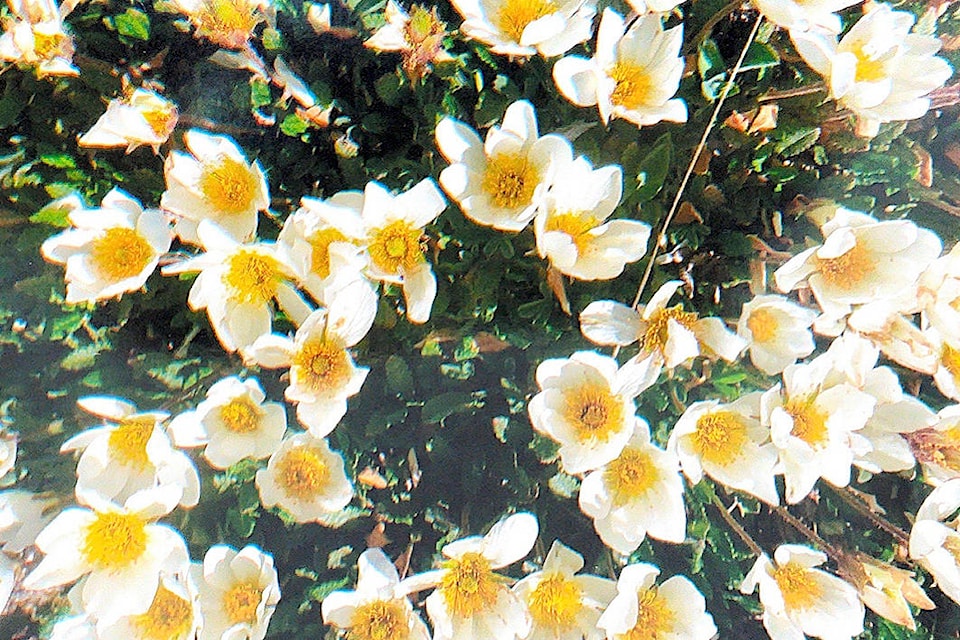By Ed McMackin
Back in the late 1950s, I learned from my school friend, Doug, that one could “wire flowers” to just about anywhere in the world. His parents were florists. On several occasions, Doug and I drove around, down Hopewell Way, to country funeral parlours to deliver flowers. At the same time, we saw some interesting embalming places. At one place, the embalming was done in a chicken coop. We didn’t always stay on the topic of flowers.
Back to the subject of wildflowers - with a little study, we would find that flowers are distributed, as well as other plants and animals in general, in interesting patterns around the world. In the northern half of our local Selkirk and Purcell Mountains, we have a striking, low-growing, mat-forming, white-flowered plants called “white mountain avens” (dryas octopetela). It is found around the world but mostly in the temperate zone of the northern hemisphere and in the arctic and subarctic regions. That kind of distribution is called “circumpolar”.
The “temperate zone” is the bands across Canada and the northern United States between the polar zones and the tropical zones, interrupted, for example, by the northern desert (Okanagan Valley), prairie,s and Carolinian Zone (Point Pelee).
North of the temperate zone, the Arctic region lies between the polar zone and the temperate zone with extensions southward on the tops of the Western, Appalachian, and Laurentian mountains, in eastern North America. It is on the tops of the Rocky Mountains that we find the white mountain avens and a few other, circumpolar arctic plant species. These islands of arctic landscape on mountain tops are often referred to as the arctic-alpine.
Other circumpolar regions have not let the white mountain avens go unnoticed. It is the flower emblem of the Northwest Territories. And guess what? It is also the national flower of Iceland! It is also found across Alaska, Northern Ireland, England, Scandinavia, the Alps, Carpathian Mountains, Balkans, and south to the Colorado Rocky Mountains. A wider distribution, in the past, is evidenced by pollen distribution.
A flower that we have found in only one spot in the north Selkirk Mountains is “nodding campion” (silene uralensis). I favor “alpine lanterns”, which another common name applied because of the unique flower shape. It is circumpolar in North America, being found in northern Alaska, the northern Rocky Mountains, Ellesmere and Parry Islands, northern Yukon, and Quebec. It also extends south into the arctic-alpine of the Rocky Mountains, which includes the Selkirk and Purcell Mountains, surrounding Kootenay Lake.
A significant number of our arctic alpine flowers are circumpolar, however, some are alternatively found on both sides of the Bering Strait. This kind of distribution is referred to as “amphiberingian”. Spring beauty, which is currently in bloom, is an amphiberingian species. The arctic-alpine roseroot (rhodiola integrifolia) is also amphiberingian, while moss campion (silene acaulis) is circumpolar. Both are found on our local mountain tops.
Twinflower (linnaea borealis) is found in the temperate zone across North America and over the Atlantic Ocean to Sweden, where it was supposed to be the favorite flower of Karl Linnaeus, a botanist of the late 1800s. It is our smallest member of the honeysuckle family. It is common in mixed and coniferous forests in the Kootenay Lake region. It has a sweet fragrance and can reach up to eight centimetres in height. One may find it in bloom in late May.
You may not get to go to Iceland, Greenland, or the Canadian Arctic, but you still see many arctic species of plants and flowers by touring our Kootenay alpine meadows and rock-turf slopes. You may also get to photograph Iceland’s national flower. If you don’t have the opportunity to hike up, then use a reference book or search online for alpine flowers. If you are looking for a particular species, it is better to use the Latin name. You will be more apt to find the right one as there may be several common names for the same species. An excellent book for the Kootenay Region is “Alpine Plants of British Columbia, Alberta & Northwest North America” by Andrew MacKinnon and Jim Pojar.
Otherwise if you would like more information, contact me at 250-866-5747 or email at anagallis77th@gmail.com.
READ MORE: Out There: Hooting, Barking, Screeching, and Fluting
